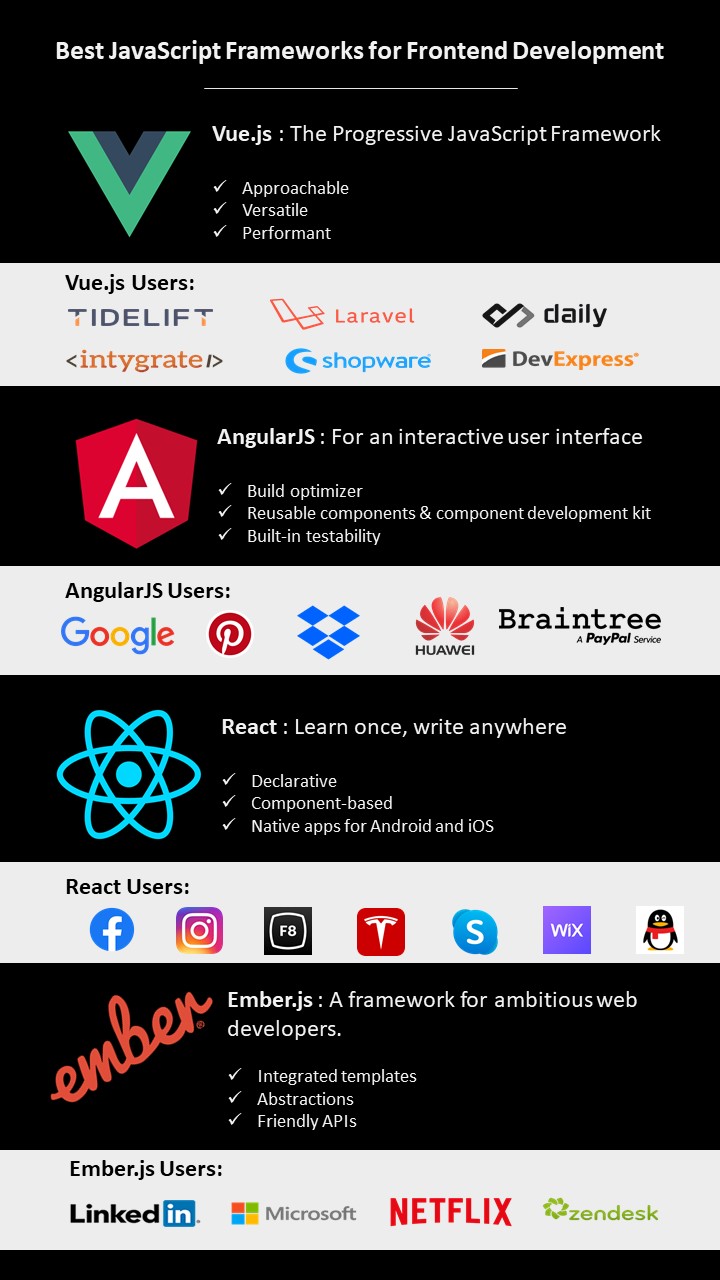With the wave of digitization, web development is rapidly evolving. Every year we see many new frameworks and platforms for application development, each with their unique benefits. However, in order to build a better audience and improve inbound sales, you need to identify which framework is best as per your requirements.
Based on our onsite and offsite web development experiences for B2B clients, I’ll list down the best Javascript framework from 2019, which you should know to stay ahead of the competition.
Best Front-end Javascript Frameworks
1. Vue.js
It is relatively new but gaining a lot of traction among the community of developers. Vue.js works with the MVVM design paradigm and has a very simple API. It demonstrates minimalism to the extreme and allows you to use selective modules as per your requirements. Inspired by AngularJS, ReactJS, knockoutJS and RivetsJS, Vue.js updates model and view via two-way data binding.
While Vue is not in the league of Angular or Ember, but conceptually it has all the potential to be the JavaScript framework of the future and hold respectable market share. It is holding the ground firmly after 10 months of its release and getting regular updates by the creator, Evan You. Vue.js has been declared as the most popular front-end JavaScript framework on GitHub with 40K stars.
Details – vuejs.org
2. AngularJS
AngularJS, the baby of Google, is the big daddy of JavaScript frameworks. It currently boasts the biggest community of developers and is also the most used JavaScript framework for developing Single Page Web Applications.
AngularJS framework gives superpowers to HTML by adding all the necessary features required to build dynamic views (interactive user interface).
It gives the option to extend HTML attributes by the use of Angular directives. Two-way data binding is at the core of AngularJS. This essentially takes away all the pain of writing manual code for DOM manipulation.
Angular 2’s final version was released in 2016. It was completely re-written, also focused on mobile apps development and was a big success. From 2016 to 2018 it has graduated further to Angular 6 as a great improvement over old. After the release of Angular 7 in October 2018, it became the most preferred framework for enterprise-level apps.
On May 28, 2019, Angular 8 was released featuring differential load for all application code, dynamic imports for lazy routes, and Typescript support. Now, Angular is integral to the MEAN stack for web application development.
Details – angularjs.org
3. React
Developers might have noticed that React is the user interface behind Facebook and Instagram. This gives us a quick idea about how powerful React is for building large-scale applications of extremely dynamic nature.
React framework is best at rendering complex user interfaces with high performance. It deploys the concept of virtual DOM (Document Object Model). React utilizes a virtual DOM, which you can render at the client-side or server-side and communicate back and forth.
The community is growing rapidly ever since its release and I must say it is the fastest-growing JavaScript framework as of today. One can find tons of resources, tutorials and React component libraries to get going within no time.
Details – reactjs.org
Also read — the basics of React Native.
4. Ember.js
Ember.js is another powerful MVC Javascript framework. Many popular websites like Discourse, Groupon, LinkedIn, Vine, Live Nation, Nordstrom, Twitch.tv, and Chipotle use Ember. Although primarily considered a framework for the web, it is also possible to build desktop and mobile applications in Ember. The most notable example of an Ember desktop application is Apple Music.
EmberJS competes with the likes of AngularJS and React when it comes to building interactive frontend user interfaces. It also has a very active community of developers.
Ember rides on the principle of two-way data binding like AngularJS. It targets the best of both AngularJS (two-way data binding) and React (server-side rendering).
Details – emberjs.com

Best Javascript Frameworks for Backend development
1. Express
When you google for Node.js frameworks, surely you might have come across Express very often. Express.js is among the top Node.js frameworks. It is an efficient platform for building robust applications and APIs. Express is also one of the four components of the popular MEAN stack (MongoDB, Express, AngularJS, and Node.js) for web application development. Here, Express serves as a middleware between the front-end, database, and back-end of an application.
Express is very flexible and lightweight and offers excellent possibilities in terms of using plugins, extensions and third-party databases. People often refer to Express as the server framework for Node.js as it creates an HTTP server for Node.js and supports the middleware functionality to respond to the HTTP requests. It has a superb set of documentation and enjoys great community support.
Details – expressjs.com
2. Sails.js
To build custom, enterprise-grade Node.js apps, Sails.js is a great fit. It mimics the MVC pattern of frameworks like Ruby on Rails but with support for the requirements of modern apps (i.e. data-driven APIs with scalable & service-oriented architecture). It is especially suitable for building chat, real-time dashboards, or multiplayer games.
Details – sailsjs.com
Last but not the least:
Meteor
Meteor is the magical isomorphic full stack platform for building an end to end mobile and web applications completely in JavaScript at a lightning fast speed. Isomorphic Javascript is also known as Universal Javascript defines the JS applications which run on both client and server. It is the power player, equipped with all the features you need for frontend rendering, backend development, business logic and database management.
The best thing about MeteorJS is that you use only JavaScript for an end to end application development, no need to invest time learning anything else. It is modular and you can use packages and libraries on demand basis. The server-side packages run in the Node.js and you do not need anything else but Meteor packages to access the database, all in JavaScript! This makes Meteor applications real-time web applications.
Details – meteor.com
Best Javascript Frameworks for 2018-2019: A Quick Recap
In recent years, Javascript emerges as the most preferred language because of the simplicity it brings to web application development. From new releases to typescript integration, the best Javascript frameworks are-
- Front end: Vue.js, AngularJS, React, and Ember.js
- Back end: Express and Sails.js
For queries and suggestions, please feel free to drop your comments or reach us at hello@mantralabsglobal.com
Happy Scripting!
Related:
Knowledge thats worth delivered in your inbox










